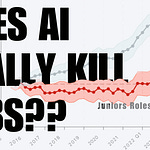Have you ever flipped a switch to turn on the lights and paused to think, "What’s that magic lighting up my bathroom?"
Or drove to work and caught yourself wondering, “What monster is propelling your seats forward? These technologies have become so seamlessly woven into our daily lives that we barely acknowledge their presence… until the moment they break down.
The last time I noticed the lift in my building was when it made cracking noises like it was trying to get my attention. So Klaas and I stood there for a minute, evaluating if we should risk our lives or suck it up and walk nine floors.
This is how I notice that I am using an AI, every day.
Unlike the unnoticed hum of electricity or the steady roar of a train engine, AI feels like an external force that demands my attention. Yes, I’m using AI to help me with ideas, construct outlines, find data, and get references. I also find myself double-checking every single response, feeling the hiccup once every few messages. So I am constantly reminded that this technology is still finding its way into the fabric of everyday life.
Electricity, radios, cars, and so on have reached a point where they operate quietly in the background, becoming invisible threads in our daily routines. In stark contrast, every interaction with AI serves as a reminder of its presence and potential to become as ubiquitous and effortless as the technologies we take for granted today.
This difference shows that the current state of AI is not yet mature enough for most AI applications to achieve product-market fit.
You might say, “Jing, AI is writing my thesis,” or “AI is recommending videos to watch on Amazon!” or “AI is removing backgrounds from my photos.” Ask yourself: How smooth is the experience? How often do you have to try again or scroll further to get what you seek?
While other technologies have become essential and invisible, AI remains a noticeable presence. Understanding this helps us grasp the challenges and opportunities as AI works to become as seamless as the technologies we take for granted.
Technology Maturity vs. Product-Market Fit.
Let’s go back to the early days of cars.
Back in the 1890s, very few people had one. People were still getting around with horses, and while cars seemed exciting, they weren’t something most people could easily use. They were expensive and explosive (yes, you heard it right), and roads were still made for carriages or your legs.
The first-ever organized car race, held in 1894, was more about reliability and endurance than outright speed. The primary challenge was not which car ran faster but whether these vehicles could even finish the race.
The idea of an “auto-mobile” was great, but the technology wasn’t ready yet. This is where technology maturity comes in. The tech (roads, engines, gas stations) needed time to catch up before cars became part of everyday life.
Today, most families in developed countries can afford a car, and we don't have to worry that it breaks down every mile. So we all want and can’t even live w/o one. This is product-market fit. The market (people like you and me) and the product (the car) are in sync.
So, just like with early cars, AI is still in the phase where the idea is exciting, but the tech isn’t quite there yet. Yes, we have ChatGPT, Copilot, and AI writers… but tell me, when was the last time you copy-paste and then done? That’s because the technology maturity isn’t fully developed. We’re in the “at least get to the finish line car race” phase of AI — where the idea is groundbreaking, but the execution still has a way to go.
Let me show you how historical technologies like electricity and the steam engine went through a similar journey — from novelty to necessity — only after years of technological improvements. And that’s where AI is headed… but it’s not quite there yet.
Listen to this episode with a 7-day free trial
Subscribe to 2nd Order Thinkers to listen to this post and get 7 days of free access to the full post archives.










